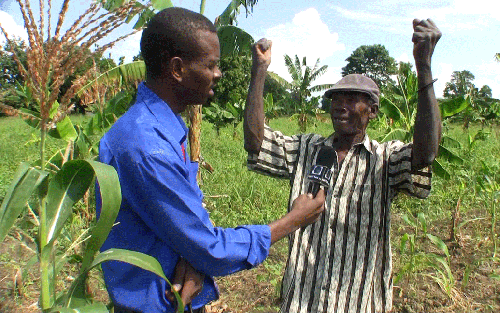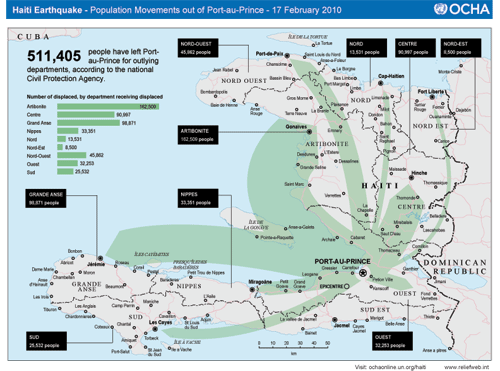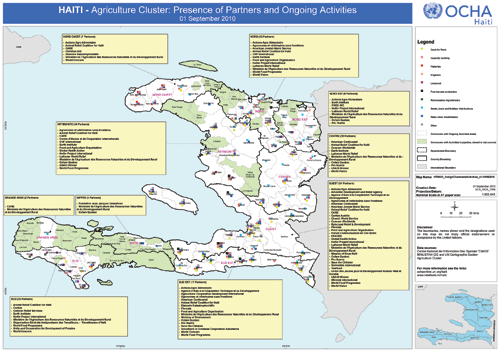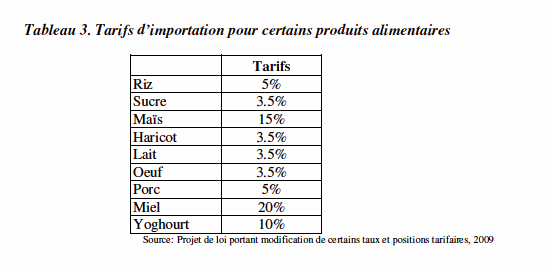Seeding Reconstruction?
Part 1 - “Project corn”
Posted March 30, 2011
Part 1 of 5
Ambroise Pierre is one of the Haiti’s better-off small farmers. His tiny plots and larger tracts near Croix des Bouquets add up to one carreau – 1.29 hectares or 3.18 acres – of land.
Still, the 73-year-old struggles to make ends meet, to feed family and to send the children to school. So, when he was offered what he calls “project corn” seed at a low price last spring, he bought some and sowed it in one of his fields.
“It made really tall plants! It looks good from afar, but up close you could see that it was useless,” Pierre said. “It had no ears.”
Pierre gestured to a now-empty field where he had planted the “project corn” he got from a $126 million dollar, US government-funded program called WINNER (Watershed Initiative for National Natural Environmental Resources). According to its website, one of WINNER’s goals is to help famers “increase their productivity and to double their incomes in five years” through the use of better irrigation and techniques, and by using better seeds, fertilizers, and other inputs provided at only a tenth the of actual cost through “Farmer’s Stores” run by local farmers organizations.
(USAID/WINNER is one of the two projects that accepted the controversial gift from Monsanto of seeds last spring. Pierre did not plant Monsanto hybrid corn, which we deal with in Monsanto in Haiti. Haiti Grassroots Watch’s numerous requests to WINNER for an interview to ask about Pierre’s corn, Monsanto seeds and other issues were turned down.)
Pierre happily bought the low-cost seed – which WINNER’s partner, a local farmers association, said was the “chicken corn” variety, but which was supplied in unlabeled, white bags: no name, no information on whether or not the seed was chemically treated (many corn seeds are coated with fungicide), no warnings.
“The price. That’s why a lot of people rushed and planted it,” Pierre explained. 
Ambroise Pierre
shows a reporter how strong and tall his corn, grown from his own seed, stand.
This season Pierre is planting the way most Haitian farmers plant: using a local corn variety he knows, with seeds from a previous harvest. The yield will be much lower than if he used an “improved” or “quality” seed variety – whether open-pollinated or hybrid – but it is something he knows, and something whose supply will never run out.
But were he offered, free or low-cost “project seeds,” would he take them? And what kind would be good for him?
When Haiti Grassroots Watch posed the question, a farmer who had been trained by WINNER whispered: “Say ‘hybrid’! Say ‘Monsanto!’ Say ‘Monsanto!’” but Pierre didn’t understand. [See Monsanto in Haiti.]
Still, the old farmer said: “Getting a gift is a marvelous thing! If it is something that’s guaranteed… but I need a guarantee. And if I have to buy it one year, but I don’t have money, that could be a problem.”
Ambroise Pierre is one of hundreds of thousands of Haitian farmers who got free or subsidized seeds last year as part of the emergency response to the January 12, 2010, earthquake.
His experience – especially his crop’s failure – might not be typical, but his dilemma illustrates the challenges facing farmers here:
• Should a farmer accept free or subsidized seed that he or she doesn’t know, without training or assistance?
• What are the risks of using a new variety without training and/or without the proper additional inputs like fertilizer and irrigation?
• Is using gifted or subsidized seed sustainable for Haitian farmers?
And there are even broader questions, related to “humanitarian” and “development” aid:
• What kind of seeds were and are being distributed in Haiti and are they correct and safe for the environment?
• How were and are recipients being chosen? And where?
• Was the “emergency” seed distribution necessary?
• Is giving away or heavily subsidizing seed sustainable for the Haitian agricultural system and for the government?
A Need for Seed?
Soon after the January 12, 2010, earthquake, humanitarian and development organization websites and newspaper articles warned of looming famine in the countryside, saying farmers may be forced to “eat their seed.”
Indeed, in the days following the massive earthquake that killed some 230,000 people the capital and three smaller cities, there was an out-migration of “internally displaced people” or IDPs to rural communities. Official estimates calculated that by mid-February, over 500,000 people were staying with friends and families in small cities or rural communities. The cost of food – in the devastated capital but also throughout the country – was going up.

Map from UN Office of Humanitarian Assistance (OCHA) showing where
Port-au-Prince refugees went.
The U.N.’s Food and Agriculture Organization (FAO) warned that a “food crisis looms in Haiti” and called for massive funding for the distribution of seeds and tools in the Haiti “Flash Appeal.” The “Flash Appeal” is how the UN coordinated humanitarian organizations seek funds in an emergency. The total requested was over $1.5 billion, of which 1,106,976,859 was received.
The FAO coordinated all the agriculture requests because it heads the “Agriculture Cluster.” Made up of development and humanitarian aid organizations like WINNER, Oxfam, Catholic Relief Services, ACDI-VOCA, as well as the Haitian Ministry of Agriculture, Natural Resources and Rural Development (MARDNR), the Agriculture Cluster is one of the 12 “clusters” or groups of multilateral, state and “non-governmental” actors. [See previous Haiti Grassroots Watch article on the Cluster system.]

Agriculture Cluster members, as of September 1, 2010. Souce: OCHA
In the Haiti “Flash Appeal,” released on February 18, 2010, the Agriculture Cluster requested $70,640,554 for 26 projects, noting that the overall objective was “to ensure that food security is safeguarded over the next 12 months on an increasingly sustainable basis.” One of its five interventions was the distribution of seeds and planting material “to those areas and households where it is known to be in short supply.”
“The FAO thinks seeds are important. For good agriculture and for better production, you need good seeds,” the FAO’s Francesco Del Re, who is also Cluster Coordinator, told Haiti Grassroots Watch. “What the FAO is doing is in accordance with the [government’s] Service National Semencier (National Seed Service or SNS) and the Ministry.”
Indeed, in a March 2010 document, the MARDNR advised that $10 million be spent buying seeds “to cover at least 30 percent of the theoretical seed needs for the next three agricultural seasons.”
But as early as March 10, Catholic Relief Service – which has extensive experience in Haitian agriculture development work – released a “rapid seed assessment” report [PDF] for southern Haiti, one of the areas worst-hit by the earthquake, saying seed distribution should not take place.
Direct seed distribution should not take place given that seed is available in the local market and farmers’ negative perceptions of external seed. This emergency is not the appropriate time to try to introduce improved varieties on anything more than a small scale for farmer evaluation.
But January 12, 2010, didn’t create Haiti’s “emergency” nor its agricultural crisis.
With virtually no state support for farmers, a skewed distribution of land, peasant’s working tiny plots, and a chaotic land tenure system characterized by exploitation and outright theft, with poorly maintained irrigation systems, poor infrastructure, and with massive deforestation and hillside farming, the lack of access to improved seeds is just one aspect of a system that has been in crisis for decades. that results in stagnating or declining agricultural production. It might seem like a small factor, but improved seeds – open-pollinated or hybrid – can increase yields by 100 percent and more. In Haiti, there is no seed certification system or seed research, and most famers don’t make any distinction between grains for eating and grains for sowing, and therefore don’t necessarily select the best genetic stock.
On top of the seed and other issues, however, for 15 years, Haitian agriculture has been reeling from a coup de grace: trade liberalization.
Under pressure from Washington (the Bill Clinton administration), and as part of a deal that enabled President Jean-Bertrand Aristide to return to Haiti after the 1991-1994, US-supported coup d’état, the Haitian government slashed the tariffs which had protected farmers from foreign competition.

Tarrifs on foreign agriculture goods. Source: Ministry of Agriculture.
“Almost overnight, Haiti became one of the world’s most open markets,” Oxfam’s Marc Cohen wrote in a recent paper.
Between 1990 and 1999, Haitian rice production fell by nearly half… From virtual self-sufficiency in 1980, today Haiti imports 80 per cent of its rice and 60 per cent of the overall food supply comes from abroad.
Part 1 of 5
Did the ministry and the Agriculture Cluster get the seed funding?
How much is being spent?
Does everyone agree that seed distribution is a priority?
See Part 2: Seed emergency or chronic crisis?
See also Monsanto in Haiti
Go to Seeding Reconstruction or Destruction? summary and the video

